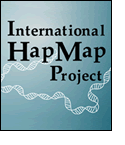Return to Online
Education Kit
|
 |
 |
 Previous Event | Next Event Previous Event | Next Event 
2002: The International HapMap Project is Announced

An international consortium announced the start of a $100 million effort to generate a next generation map of the human genome. The International HapMap Project aimed to provide data on human genetic variation that could be used to speed the identification of genes associated with common diseases such as asthma, cancer, diabetes, and heart disease. The project was expected to take about three years to complete. While the Human Genome Project focused on obtaining the DNA sequence from a single individual, the HapMap Project was concerned with genetic variation among human populations. To create the HapMap, DNA samples were obtained from individuals from Nigeria, Japan, China, and the United States. Financial support for the project comes from public and private sources located in the participating nations.
More Information
The HapMap Project builds upon the sequence data assembled by the International Human Genome Sequencing Consortium. Human beings are much more alike than they are different. The genomes from two individuals are 99.9 percent identical. The 0.1 percent difference is important, as it accounts for why people look different from one another and for their differing susceptibilities to diseases. Most of the genetic variation in the human genome consists of single nucleotide polymorphisms called SNPs (pronounced “snips”). To date over 2.8 million of these SNPs have been identified. It is estimated that the human genome contains more than 10 million SNPs. Scientists would like to be able to associate various disease susceptibilities with specific collections of SNPs. Unfortunately, this is not feasible using today’s technology. Instead, the HapMap Project characterizes larger chunks of the genome that are inherited together. Called haplotype blocks, these larger portions of the genome can be identified by using just a few unique SNPs as tags. Research indicates that about 65 to 85 percent of the genome can be organized into haplotype blocks of 10,000 bases or larger. Using the HapMap shortcut will require characterizing only 250,000 to 600,000 SNPs out of the estimated 10 million that are present.
In the past, scientists have identified genetic variation that is associated with relatively rare single gene disorders. Most common diseases such as cancer and heart disease are influenced by several to many genes that each interact with the environment. It is much more difficult to identify genes that contribute just a small amount to a disease phenotype. In using the HapMap data, researchers will compare haplotype patterns from people who have a disease with the patterns from people who are healthy. If a particular haplotype pattern is more often seen among people with the disease, then researchers will analyze that portion of the genome in detail looking for a genetic variant associated with the disease. Genetic variation also is known to be involved with an individual’s response to drugs, toxins, and environmental exposures. Someday, HapMap data may be used to personalize medical care.
 Previous Event | Next Event Previous Event | Next Event 
Last Reviewed: April 10, 2008
|

